Are you ready to take your DIY projects to the next level? Fabric dyeing is a fun and rewarding way to transform plain textiles into personalized works of art. Whether you’re a beginner or an experienced crafter, this comprehensive guide to Fabric Dyeing Mastery will equip you with the skills and knowledge you need to create stunning designs on all kinds of fabrics.
In this guide, we’ll take you step-by-step through the fabric dyeing process, from understanding the basics to exploring more advanced techniques. You’ll learn how to choose the right dye for your fabric, prepare your textile for dyeing, and troubleshoot common issues that may arise. With our help, you’ll be able to achieve vibrant and long-lasting colors on all your fabrics.
So, let’s get started on your journey to becoming a fabric dyeing master!
- Learn fabric dyeing step-by-step, from basics to advanced techniques.
- Discover fabric dyeing tips and tricks to achieve unique effects and patterns.
- Choose the right dye for your fabric type to achieve vibrant and long-lasting results.
- Proper preparation and care for your dyed fabrics to preserve the color and longevity of the dye.
- Explore inspiring fabric dyeing projects to unleash your creativity.
Fabric Dyeing for Beginners: Understanding the Basics
If you’re new to fabric dyeing, it’s important to start with the basics. The most common dyeing methods for beginners include:
- Immersion dyeing: This involves fully submerging the fabric in dye.
- Tie-dyeing: This is a popular method for achieving unique patterns by folding or twisting the fabric and securing it with rubber bands before dyeing.
- Dip-dyeing: With this method, you partially dip the fabric in dye to create a gradient effect.
Before you begin, make sure to:
- Choose the right dye for the fabric type.
- Wash and pre-treat the fabric.
- Prepare your dye according to the instructions.
- Protect your workspace and wear gloves to avoid staining your skin.
Once you’ve mastered the basics, you can move on to more advanced techniques and achieve stunning results on all your fabric projects.

Ready to take your fabric dyeing skills to the next level? Here are some advanced techniques that will help you create unique effects and patterns on your fabrics:
- Resist dyeing: This technique involves using a substance like wax or glue to create designs on the fabric that will resist dye absorption, resulting in a patterned effect.
- Ombre dyeing: Gradually fading the color of the fabric from dark to light or light to dark creates a stunning ombre effect.
- Batik dyeing: A technique used to create intricate designs by applying wax to fabric, which is then dyed. The wax resists the dye, creating a pattern.
Here are some tips to help you achieve the best results with these techniques:
- Be patient and take your time. Advanced techniques require more time and attention to detail.
- Experiment with different colors and patterns to find what works for you.
- Make sure to follow the instructions carefully for each technique.
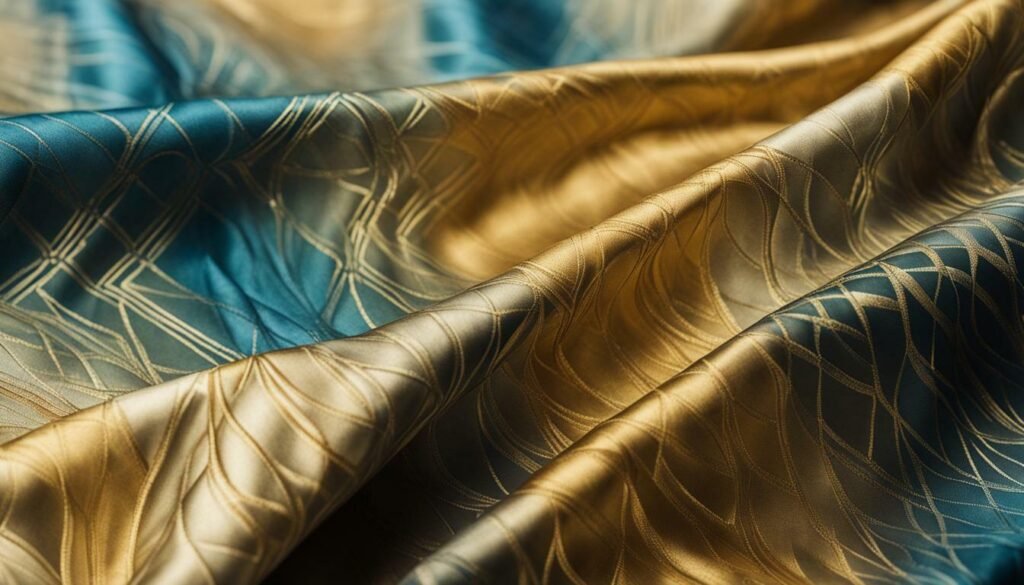
Proper preparation of your fabric is crucial for a successful dyeing process. Follow these steps for prepping your fabric before dyeing:
- Wash your fabric to remove any dirt, debris, or sizing that may interfere with dye absorption
- Pre-treat your fabric according to the dye manufacturer’s instructions to ensure the dye adheres evenly
- Choose the appropriate fabric dyeing method for your fabric type, such as immersion dyeing, tie-dyeing, or dip-dyeing
- Wear protective gear such as gloves, goggles, and a dust mask to avoid direct contact with the dye and prevent inhalation of dye particles
- Prepare your dye solution according to the manufacturer’s instructions, and keep in mind that color intensity will vary depending on the ratio of dye to water
- Follow the appropriate dyeing method, and stir your fabric regularly to ensure even coverage of the dye
- Rinse your dyed fabric thoroughly with cool water until the water runs clear, and then wash with a mild detergent to remove any excess dye
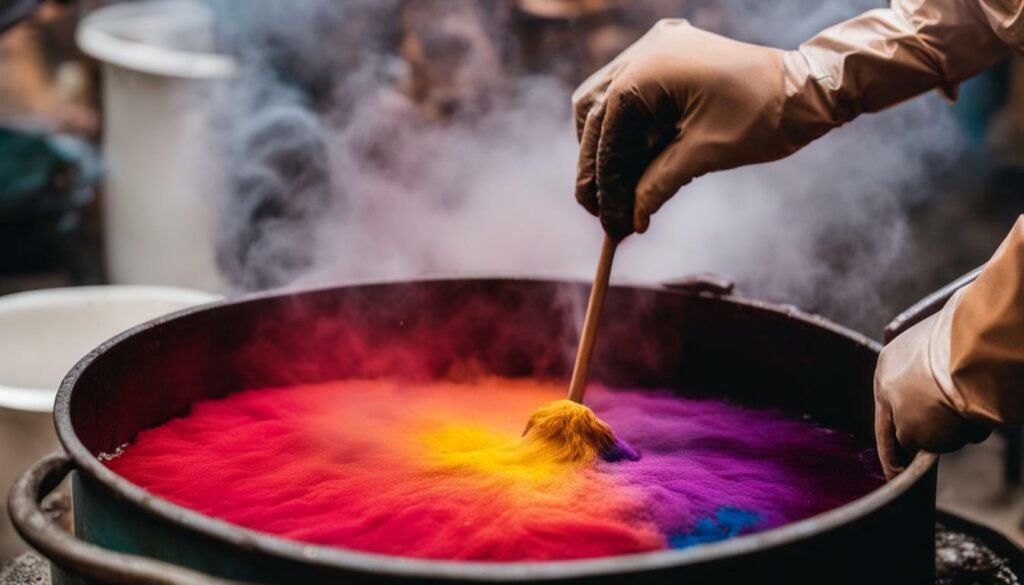
Professional fabric dyeing requires selecting the right dye for optimal results.
- Different dye types available for use include fiber reactive dyes, direct dyes, acid dyes, and natural dyes.
- Fiber reactive dyes are best for cotton, linen, hemp, and other cellulose fibers.
- Direct dyes are ideal for silk, wool, and nylon.
- Acid dyes are suitable for protein-based fibers like wool, cashmere, silk, and nylon.
- Natural dyes are derived from plant or animal sources and are environmentally friendly, but may not yield as vibrant or long-lasting results as synthetic dyes.
When selecting a dye, consider the type of fabric you’ll be dyeing and the desired outcome. Remember to always follow the manufacturer’s instructions and wear protective gear when working with dyes.
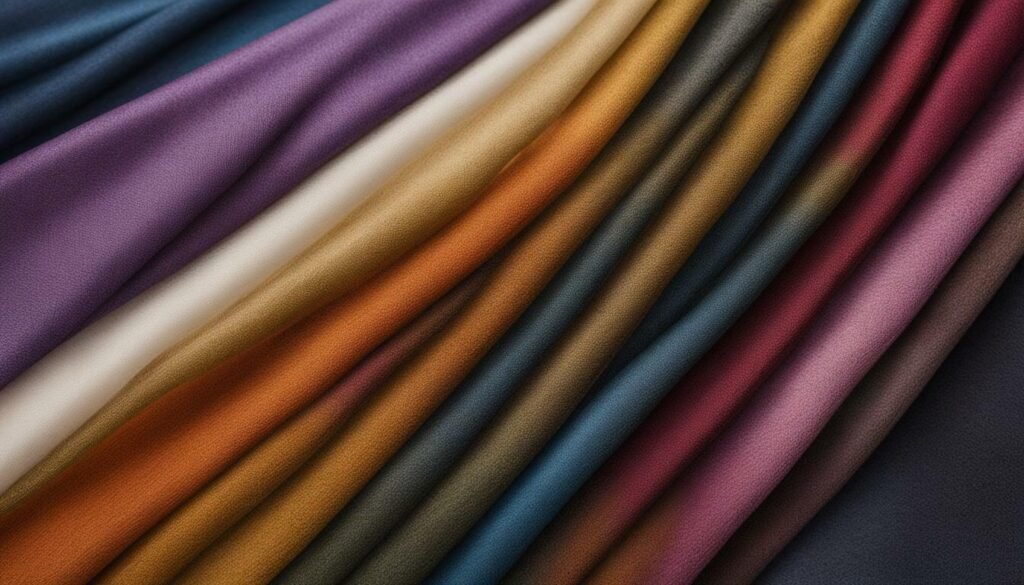
Before you dive into fabric dyeing, it’s important to have the right tools and materials on hand. Here are the essentials:
- Fabric dye
- Salt or vinegar (depending on the dye type)
- Protective gloves
- Protective eyewear
- Measuring cups and spoons
- Mixing bowls or buckets
- Stirring utensils
- Water source
- Pre-washing detergent
- Iron (if necessary for fabric preparation)
If you’re a beginner, you’ll want to start with a kit that includes all of the necessary supplies. As you become more experienced, you can purchase individual materials.
When selecting your materials, keep in mind that different fabric types require different dyes and preparation methods. Choose your dye and other materials based on the fabric you’ll be working with.

Now that you have your supplies gathered, you’re ready to start dyeing. In the next sections, we’ll explore various fabric dyeing techniques and provide step-by-step guidance to help you get started.
Understanding Color Theory in Fabric Dyeing
Color plays a vital role in fabric dyeing, and understanding color theory is essential to achieving the perfect hue. Here are some fabric dyeing tips to help you master color:
- Primary colors are red, blue, and yellow. Mixing these colors in equal parts will create secondary colors: orange, purple, and green.
- Complementary colors are opposite each other on the color wheel (such as red and green) and can be used together to create a striking effect.
- You can create custom shades by mixing dyes together. Start with a small amount of dye and gradually add more until you achieve the desired color.
- Remember that different fabric types absorb dye differently, so the same color may appear differently on different fabrics.
By experimenting with color combinations and techniques, you can create stunning effects that reflect your personal style. Don’t be afraid to get creative and explore the possibilities of color in fabric dyeing.
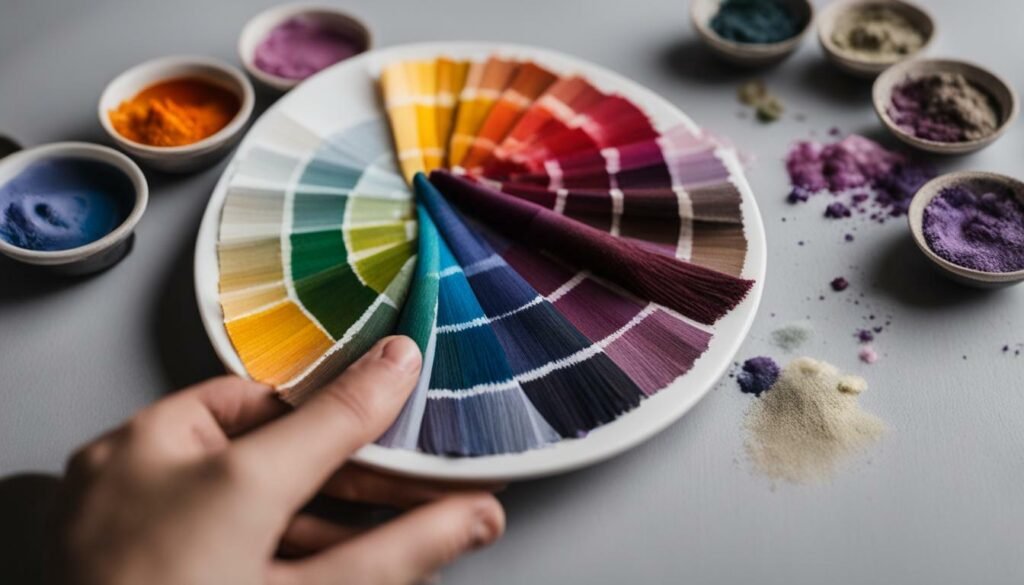
There are several fabric dyeing methods that you can use to achieve different results. Here are some of the most popular methods:
- Immersion dyeing: This involves fully submerging the fabric in a dye bath to achieve an even color. It works best for solid colors, and you can use multiple dyes to create custom shades.
- Tie-dyeing: This method involves binding and twisting fabric in specific areas with rubber bands to create unique patterns. You can experiment with different folding and binding techniques to achieve various designs.
- Dip-dyeing: Dip-dyeing involves dipping one end of a fabric in a dye bath, gradually increasing the amount of fabric you submerge to create an ombre effect. This method works best for achieving gradient colors.
Regardless of the method you choose, the fabric dyeing process typically involves preparing the fabric, mixing and applying the dye, and fixing the color with heat or a fixing agent.
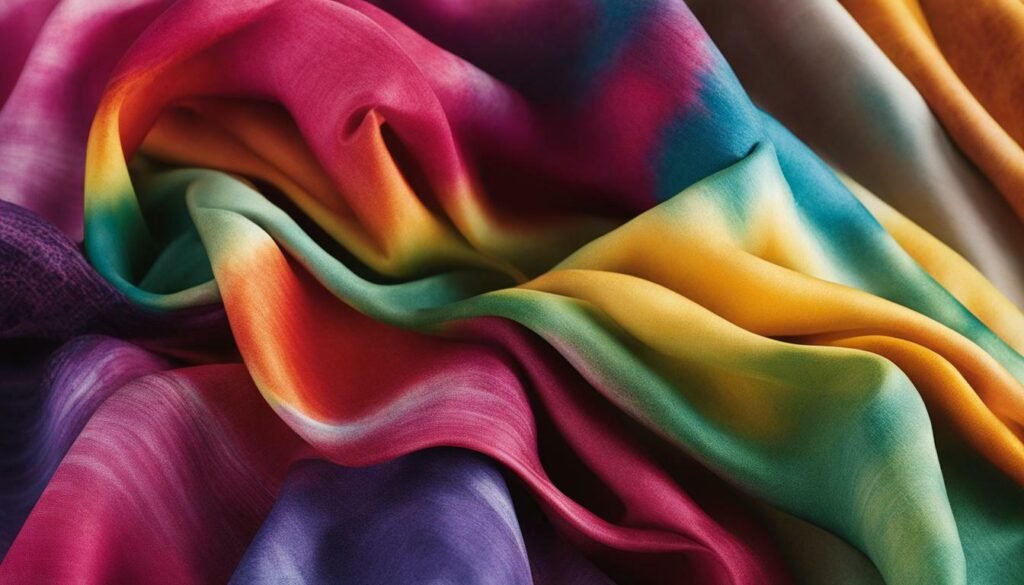
Ready to take your fabric dyeing skills to the next level? It’s time to experiment with special effects! Below we’ll share some advanced fabric dyeing tips to help you achieve new and exciting patterns on your fabrics:
- Shibori: This Japanese dyeing technique involves folding, twisting, and binding fabric to create intricate patterns. You can use a variety of materials to bind the fabric, such as rubber bands, thread, or wooden blocks.
- Batik: Batik is a wax-resist dyeing technique that originated in Indonesia. You can use hot wax to create designs on your fabric, apply the dye, then remove the wax to reveal the pattern.
- Marbling: With marbling, you can create a unique swirling effect on your fabrics. Simply drop different colors of dye onto a liquid surface, swirl them together, then dip your fabric in the mixture.

With these fabric dyeing tips, you’re ready to take your projects to the next level. Get creative and see what unique designs you can create!
Fixing and Caring for Dyed Fabrics
Now that you’ve successfully dyed your fabric, it’s important to take proper care to ensure the color and vibrancy last as long as possible. Follow these steps to fix and care for your dyed fabrics:
- Immediately after dyeing, rinse the fabric thoroughly with cool water to remove any excess dye and prevent bleeding.
- Add a fabric fixative or vinegar to a clean water bath and soak the fabric for 15-30 minutes to help set the color.
- Wash the fabric in cold water with a mild detergent, avoiding any bleach or fabric softeners that can cause fading.
- Avoid drying dyed fabrics in direct sunlight, as this can also cause fading. Instead, hang or lay the fabric flat to air dry in a shaded area.
- If your fabric still bleeds color after washing, repeat the fixative or vinegar soak and wash again.
By following these simple steps, you can help ensure that your dyed fabrics stay vibrant and beautiful for a long time to come.
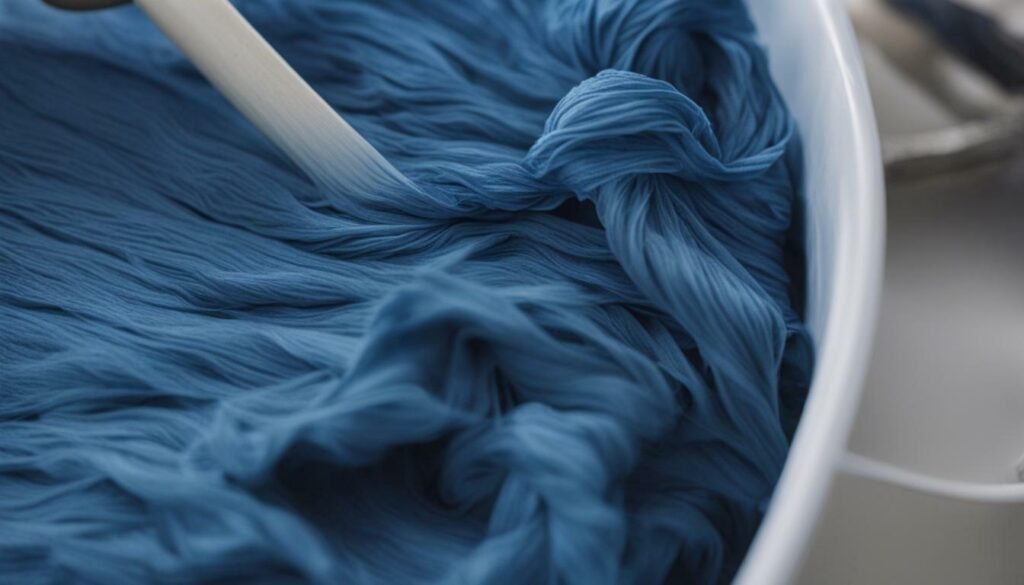
Fabric dyeing can be a fun and rewarding experience, but it’s not without its challenges. Here are some common issues you may encounter during the dyeing process and tips to help you troubleshoot them.
- Uneven color distribution: This can happen when the fabric is not stirred enough during the dyeing process. To prevent this, make sure to stir the fabric frequently while it’s in the dye bath.
- Color bleeding: If the dye is bleeding onto other areas of the fabric, it may be because the fabric was not rinsed thoroughly enough before dyeing. Rinse your fabric multiple times to ensure all excess dye has been removed.
- Fading over time: If your dyed fabric is fading quickly, it may be because the dye was not set properly. Make sure to follow the instructions on your dye package for setting the color.
- Staining on other fabrics: If dye transfers onto other fabrics, it may be because the dyed fabric was not washed separately enough or washed with other fabrics too soon after dyeing. Wash your dyed fabric separately for the first few washes to prevent color transfer.
With these troubleshooting tips, you can overcome any challenges that come your way and achieve stunning results with your fabric dyeing projects. Remember, practice makes perfect, so don’t be afraid to experiment and try new techniques.
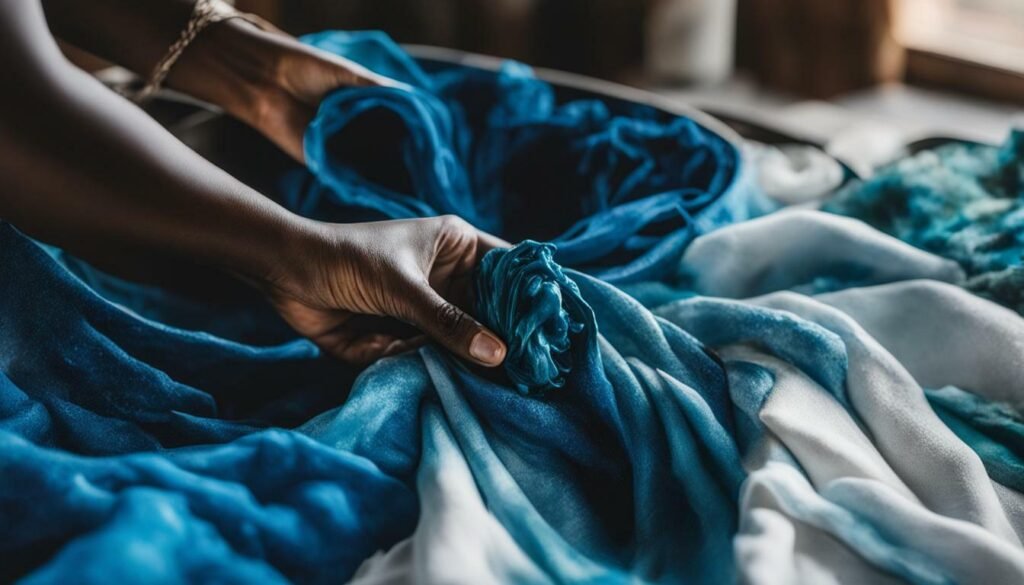
Now that you’ve gained mastery over fabric dyeing techniques, it’s time to put your skills to the test with some inspiring projects. Here are a few ideas to get you started:
- Create a tie-dye t-shirt or hoodie. This classic technique is perfect for beginners and adds a pop of color to your wardrobe.
- Dip-dye a plain white bedsheet or pillowcase to create an ombre effect. This technique is easy to execute and creates a stunning visual impact.
- Experiment with shibori dyeing to create unique patterns and textures on your fabrics. This advanced technique involves folding, twisting, and binding your fabric before dyeing, resulting in stunning abstract designs.
- Transform plain cotton napkins into colorful statement pieces with block printing and fabric dyeing. Cut your own custom stamps or use pre-made designs to create a personalized look.
Remember to have fun and experiment with different techniques to create your own one-of-a-kind textiles. Whether you’re a beginner or an advanced dyer, there’s no limit to what you can create with fabric dyeing.
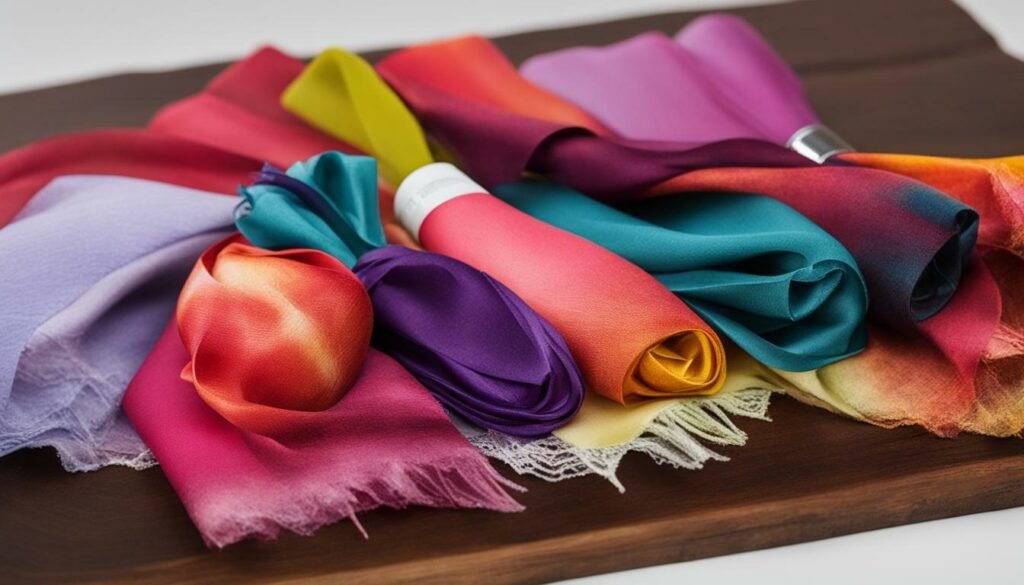
Congratulations on completing Fabric Dyeing Mastery! With your newfound knowledge and skills, you’re ready to take on any fabric dyeing project and create unique textiles that reflect your personal style. Here are some key takeaways:
- By understanding the basics of fabric dyeing, you can achieve successful results every time.
- Choosing the right dye and preparing your fabric properly are crucial for achieving vibrant and long-lasting colors.
- There are various fabric dyeing methods and techniques to explore, from immersion dyeing to shibori and batik.
- Don’t be afraid to experiment with color combinations and special effects to create one-of-a-kind fabrics.
- Proper care and maintenance are essential for preserving the color and quality of your dyed fabrics.
As you continue to practice and refine your fabric dyeing skills, remember to have fun and keep exploring new techniques and projects. With Fabric Dyeing Mastery, the possibilities are endless. Happy dyeing!
FAQ
What will I learn in this comprehensive guide?
In this guide, you will learn everything you need to know about fabric dyeing. From basic techniques to advanced methods, we will take you step-by-step through the process of transforming your textiles.
What are the basics of fabric dyeing?
Before diving into fabric dyeing, it’s important to understand the basics. In this section, we will explore different fabric dyeing methods suitable for beginners and guide you through each step of the process.
How can I take my fabric dyeing skills to the next level?
If you’re ready to advance your fabric dyeing skills, this section will introduce you to more advanced techniques. Discover tips and tricks for achieving unique effects and patterns on your fabrics.
How do I properly prepare my fabric for dyeing?
Properly preparing your fabric is crucial for successful dyeing results. In this section, we will walk you through the step-by-step process of prepping your fabric, from washing and pre-treating to choosing the right dyeing method for your fabric type.
How do I choose the right dye for my fabric?
Not all dyes are created equal. In this section, we will discuss the different types of dyes available and provide guidance on selecting dyes that will yield vibrant and long-lasting results based on your specific fabric.
What tools and materials do I need for fabric dyeing?
To master fabric dyeing, you’ll need the right tools and materials. In this section, we’ll outline the essential supplies you’ll need to get started, from measuring and mixing tools to protective gear.
How can I learn about color theory in fabric dyeing?
Achieving the perfect color in fabric dyeing requires an understanding of color theory. In this section, we’ll dive into the basics of color mixing and how to create custom shades, helping you experiment with color combinations and create stunning effects.
What are the different fabric dyeing methods I can use?
There are several methods you can use to dye fabric, each yielding different results. In this section, we’ll explore various fabric dyeing techniques, including immersion dyeing, tie-dyeing, and dip-dyeing, and help you determine which one suits your project best.
How can I achieve special effects in fabric dyeing?
Elevate your fabric dyeing projects with special effects. In this section, we’ll share techniques for creating unique patterns and textures on your fabrics, such as shibori, batik, and marbling, and show you how to incorporate them into your dyeing repertoire.
How do I fix and care for dyed fabrics?
Once you’ve dyed your fabric, proper care and maintenance are essential for preserving the color and longevity of the dye. In this section, we’ll provide tips on fixing the dye, setting the color, and caring for your dyed fabrics to ensure they stay vibrant for years to come.
What should I do if I encounter issues during the fabric dyeing process?
Fabric dyeing doesn’t always go as planned. In this section, we’ll address common issues and challenges that may arise during the dyeing process and offer troubleshooting tips and solutions to help you overcome any obstacles.
Can you provide inspiring fabric dyeing project ideas?
Absolutely! In this section, we’ll showcase inspiring projects that you can try at home, from tie-dye t-shirts to gradient pillowcases. We’ll provide step-by-step instructions and ideas to fuel your creativity.
Can you sum up what I’ve learned in this guide?
Congratulations on completing Fabric Dyeing Mastery! In this final section, we’ll summarize the key takeaways from this guide and encourage you to continue exploring and experimenting with fabric dyeing to unleash your creative potential.
